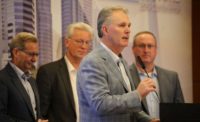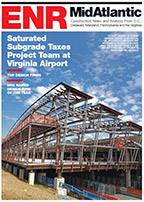...recommendation, legislation already has been enacted that shifts the country from a confrontational and defensive posture to a 100-year plan focusing on adaptation, sustainability and a movement toward “building with nature,” which seeks to encourage natural forces to bolster shorelines, dunes and marshes to enhance storm protection.
Sen. Mary Landrieu, D-La., who serves on the Appropriations and Energy and Natural Resources committees, said, “We have to stop fighting it [water] and learn to live with it and be respectful. It’s nature.” She said regional approaches to flood defenses and water management are needed, but they should be coordinated to advance commerce and industry. Landrieu says she is discussing such a plan for the Gulf Coast with the Obama administration now.
One thing made apparent throughout the conference is the cross-Atlantic knowledge exchange already is being fed by a stream of bilingually produced studies and publications. The Dutch experts, whose water-management policy and practices are couched in 1,000 years of experience living on land wrested from the sea, publish their works in both Dutch and English.
Several new publications circulated. One, delivered to the conference just off the press, is entitled “Connecting Delta Cities: Coastal Cities, Flood Risk Management and Adaptation to Climate Change,” which is the first publication of a Rotterdam-sponsored, connecting-delta-cities initiative. The group held a workshop in New York City in June to weigh the climate-change challenges facing New York, Rotterdam, Jakarta and London and, by extension, delta cities worldwide. It also compared the adaptation strategies planned or implemented. The conclusion drawn is that a broad systems approach is required and planners need to integrate adaptation strategies into current infrastructure investments as choices made today may reduce risk to assets and people far into the future. More information is available at www.deltacities.com.
The list of authors and their affiliations demonstrates the reach of the network that is developing: Jeroen Aerts, a professor in water, risk and insurance at VU University, Amsterdam; David C. Major, senior research scientist at the Earth Institute, Center for Climate Systems Research at Columbia University, New York City; Malcolm J. Bowman, a professor of physical oceanography at the Marine Sciences Research Center at Stonybrook University, Stonybrook, N.Y.; Piet Dircke, water program director at Arcadis and a professor of urban water management at Rotterdam University of Applied Sciences; and Muh Aris Marfai, a professor of geography at Gadjah Mada University, Yogyakarta, Indonesia.
The port city of Rotterdam already is dealing with water-management issues attributed to climate change. It seems to be leading the way in developing adaptation strategies as it deals with effects including sea-level rise, a rising water table, storm-surge threats and increasing rainfall, including increasingly frequent heavy-rain events across the vast continental watershed drained by the rivers passing through the city. Rotterdam and the Netherlands are responding with a range of policy, planning and engineering initiatives to move the country away from its confrontational approach to water—illustrated by the vast array of dikes, levees, surge barriers and gates—to a carbon-neutral society living with the water and encouraging natural processes to strengthen the shorelines and soils of the hinterlands.
Another new publication picked up at the conference, sponsored by the Rotterdam Climate Initiative, is “REAP: Rotterdam Energy Approach and Planning,” by Nico Tillie and others. The city has a target of returning to 1990 levels of carbon-dioxide emissions by 2025 and ultimately wants to become carbon-neutral. REAP proposes accelerating the move by changing the current strategy of reducing energy demand, generating renewable energy and maximizing the efficient use of fossil fuels, by adding a new emphasis on re-using waste energy by creating heat exchange networks for clusters of structures. Such a network would capture heat by-products of industrial and commercial operations either to charge underground storage banks, or directly cascade it to other users, including homes and agriculture. A pdf version will soon be posted at www.aiany.org, which already has the original academic paper upon with the book was based.
A third book getting distribution is a tour-de-force: the 450-page “Integrated Coastal Policy via Building With Nature, 2nd Edition,” by Ronald E. Waterman, member of parliament of the province of South-Holland. It is the product of decades of scientific study and advisory involvement in coastal development projects all over the world and includes case studies on two dozen signature projects scattered across the globe.




Post a comment to this article
Report Abusive Comment